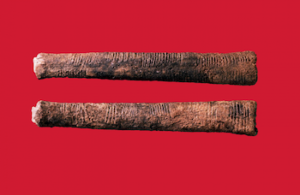
Ishango Bone
*National Pi Day is marked on this date in 1988. This is an annual celebration of the mathematical constant π (pi). In 2009, the United States House of Representatives supported the designation of Pi Day.
Symbolically, this celebrates the discovery of the Ishango bone, perhaps the oldest mathematical artifact in existence. The Ishango bone is a bone tool dated to the Upper Paleolithic era. It is a dark brown bone, the fibula of a baboon, with a sharp piece of quartz affixed to one end. It was first thought to be a tally stick, as it has a series of what has been interpreted as tally marks carved in three columns running the length of the tool. More scientists have suggested that the groupings of notches indicate a mathematical understanding beyond counting. The artifact was first estimated to have originated between 9,000 BC and 6,500 BC. However, the dating of the site where it was discovered was re-evaluated, and it is now believed to be more than 20,000 years old.
Belgian archeologist Jean de Heinzelin de Braucourt discovered it in 1960 while exploring the (then) Belgian Congo. It was found in the Ishango area near the Semliki River. Part of Lake Edward empties into the Semliki, which forms part of the headwaters of the Nile River (now on the border between modern-day Uganda and Congo). The bone was found among the remains of a small community that fished and gathered in that area of Africa. The settlement had been buried in a volcanic eruption.
Some scientists believe the three columns of asymmetrically grouped notches imply that the implement was used to construct a numeral system. The central column begins with three notches and then doubles to 6 notches. The process is repeated for the number 4, which doubles to 8 notches, and then reversed for the number 10, which is halved to 5. These numbers may not be purely random and instead suggest some understanding of the principle of multiplication and division by two.
The bone may have been used as a counting tool for basic mathematical procedures. Furthermore, the numbers on the left and right columns are odd (9, 11, 13, 17, 19, and 21). The numbers in the left column are all prime numbers between 10 and 20 (which form a prime quadruplet), while those in the right column consist of 10 + 1, 10 − 1, 20 + 1, and 20 − 1. The numbers on each side column add up to 60, with the numbers in the central column adding up to 48.
In the book How Mathematics Happened: The First 50,000 Years, Peter Rudman argues that the development of the concept of prime numbers could have come about only after the idea of division, which he dates to after 10,000 BC. Prime numbers probably were not understood until about 500 BC. He also writes, "No attempt has been made to explain why a tally of something should exhibit multiples of two, prime numbers between 10 and 20, and some numbers that are almost multiples of 10."
Alexander Marshack examined the Ishango bone microscopically and concluded that it may represent a six-month lunar calendar. Still, Judy Robinson debates that Marshack over-interprets the data and that the evidence does not support lunar calendars. Claudia Zaslavsky has suggested that this may indicate that the tool's creator was a woman, tracking the lunar phase in relation to the menstrual cycle.
The Ishango bone is on permanent exhibition at the Royal Belgian Institute of Natural Sciences, Brussels, Belgium.
To Become a mathematician or statistician.